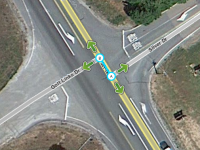When creating a segment, it is important to ensure that any individual segment is at least 19.69 ft (6 m). It is less important to keep segments under any particular length, but there are drawbacks to long segments discussed below.
Length issues
Too short
When a segment is less than 19.69 ft (6 m) it becomes difficult for the navigation engine to determine traffic speed through that segment. That will in turn negatively affect drive time estimations and best routing.
Between intersections

There may be times when driveways or other roads join a main road with close proximity to each other. This may cause small segments to be created between the two junctions along that main road. If the segment is shorter than 19.69 ft (6 m), it may be best to simply merge the two intersections into a single junction. It is OK if the joining roads in the map do not exactly align with the visual map in the Waze Map Editor.
See the Junction Style Guide section on offset roads for more details about this situation.
Too long
There are no system operation issues that require limiting the length of a segment, but there are a number of reasons that would make things better by limited the length.
A segment should not have unnecessary junctions, but some two-segment junctions may be present for the following reasons:
- Long roadways or railroads with the city name present will cause a smudged city issue on the city layer.
- Segments that extend outside of an editor's editable area cannot be modified in any way. Keeping roads shorter than 10,000 meters reduces the chances of editors running into more roads with this restriction.
- Long segments require more resources in the client and WME when rendering them on screen.
- At one time there were issues surrounding segments over 10,000 meters. The junction may be present due to this reason alone.
Determine the length
The length of a segment can be determined after it is created and saved by selecting it and looking at the general tab with the segment selected. The length will be displayed toward the bottom of the tab in meters. The length does not appear before it is saved.
Fixing short segments
There are a few instances where a single short segment may be present between two other segments with no other segments at those junctions. Sometimes these junctions are necessary and should not be removed. These include:
- Loop roads. A single segment cannot loop back upon itself, so a junction is required to create two separate segments. It does not matter where the junction is located, so long as each segment meets the minimum segment length. Some roads have two separate segments that share the same start and end junctions creating two alternate paths between them. These configurations cause routing problems and require one of the two segments to have a 2-segment junction. More details are covered in Junction Style Guide on Loops.
- Ramp or freeway splits. There are cases where a freeway may split into two separate freeways. In order to provide navigation to drivers, it may be necessary to create short segments on the freeway to show the two different road names at the split. Under certain situations it may be best to make the segments as short as possible, so long as each segment meets the minimum segment length. This is covered in detail in the Junction Style Guide.
- Long segments. Segments are best kept under a certain distance.
- Segment Property Change. When a segment property changes between intersections, a two-segment junction may be required:
- Road, city, or state name change. When the road, city, or state name changes between intersections, add a junction so the segments on either side may have a different name.
- Elevation Change. When elevation changes at complex interchanges, a junction can be added to introduce an elevation change.
- Speed Limit Change. When the speed limit changes between intersections, add a junction so the segments on either side may have a different speed limit.
In the above cases, the segment is necessary so it cannot be deleted, but it can be made the minimum length and still meet the needs of the original purpose.
Fixing long segments
Simply add a junction point along the segment length which will result in the two segments being less than the recommended length. If the segment is more than two times longer than the maximum, then consider adding two (or more) additional junction points.